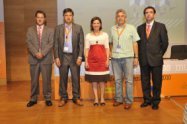
FEDERACION ESPAÑOLA DE MUNICIPIOS Y PROVINCIAS
- Contact |
- Who are we? |
- Site Map |
- Job offers
Three municipalities rewarded for their efforts for sustainable rural development
La Aldea de San Nicolás (Gran Canaria), Coca (Segovia) and Somiedo (Asturias) I have received the Award of Best Practice for Sustainable Rural Development. The awards have been handed over by the Minister for Environment and Rural and Marine Affairs, Elena Espinosa, during the first day of the Congress of Small Towns, held in Toledo, organized by the FEMP.
The model of agricultural waste management, undertaken by the City of La Aldea de San Nicolás, extraction of natural resins as a source of employment, sponsored by the City of Coca and the project "s cattle ranchers to school", being conducted by Somiedo City Council since 2007, have been recognized among 38 local initiatives as best practices for sustainable rural development as part of the I Competition on the subject, organized from the FEMP.
Employment and sustainable development
The three winning practices have in common the desire of the proponents for the creation of employment and population settlement, all from the momentum of sustainable development, albeit from different perspectives depending on the particularities of each municipality.
Thus, in La Aldea de San Nicolas, one of the last agricultural and scenic reserves remaining in Gran Canaria, which has in its territory with four protected natural areas, including, in fact, in the World Biosphere Reserve of western island, the implementation of its management model of agricultural waste is already showing visible results on the landscape and promises in the short to medium term, a favorable impact on employment in the area.
The initiative has earned them this recognition, "and also the Spanish Habitat Committee has chosen to attend practice at the Contest of United Nations Practice," has come to solve the problem posed by agricultural waste in this county: La Aldea de San Nicolas, whose economic development is based on intensive cultivation of tomatoes for export, had to deal with the crisis caused by waste from the agricultural activity; address the situation, the municipality promoted its new model, a strategy to promote the socioeconomic development of the territory by reducing levels of unemployment and improving sanitation and hygiene in farms and their surroundings.
Integrated interventions involving Administration and private sector, creation of technical committees and other activities have allowed the new model to promote waste management and progress towards objectives, among others, lower levels of unemployment, restore agricultural production, combat and prevent pests or equipped with adequate infrastructure.
Resin extraction as a source of employment
Improving efficiency in the extraction process has allowed Coca resins to create over 150 direct and indirect jobs, thereby contributing to the settlement population. So give effect to two of the goals that this City Council, in collaboration with the Community of Villa y Tierra de Coca, was raised by experimenting with new techniques of resin.
The use of derivatives of natural resins in place of oil is a bet of European industry by reducing CO2 emissions resin is a natural, renewable product that currently comes mainly from imports emerging countries; Coca plot has the largest in Europe, with 18,000 pine resin producers, a space that both the City Council and the Community of Villa y Tierra considered optimal to experiment with new lines of resin, to train employees in the process and disseminate the results obtained.
Dignify livestock
The objectives of making known from school the importance of livestock in the municipality, dignify it as a profession and present it as an economical option for the future of young people, moved in 2007 to the City Somiedo Spaniard, together with the Government of the Principality of Asturias and the Association of Cattle Breeders Select Raza Asturiana de los Valles-ASEAVA-to launch a curious activity with children. It was allowed to participate in a "Livestock Competitions Jury" specifically for children, in line from that for adults.
The process involves three sessions: the first, introductory, with the participation of technicians from ASEAVA, in the classroom explaining what should be a farm to be profitable and environmentally friendly, and how to form a farmer; the second session, which adjusts for the children the current certification process for adults, taught in the cattle market differentiation of morphological traits that differentiate the value it already won according to them, the third and final session, with the evidence obsolete, is the granting of license and diploma, with which children can act as jurors in the livestock competitions, with their assessment, will be awarded a special prize of the "Children's Jury." Currently, scores of students act as jury in the National Contest Herds of Asturiana de los Valles.

